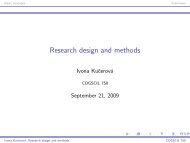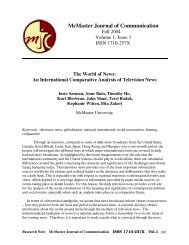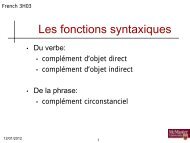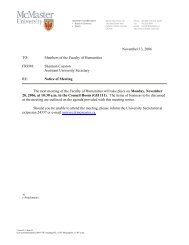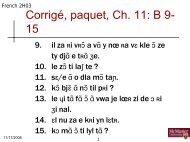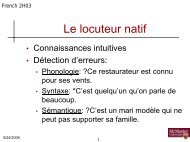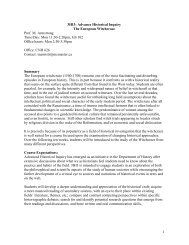The Syntax of Givenness Ivona Kucerová
The Syntax of Givenness Ivona Kucerová
The Syntax of Givenness Ivona Kucerová
You also want an ePaper? Increase the reach of your titles
YUMPU automatically turns print PDFs into web optimized ePapers that Google loves.
. Marie dala koně || Pavlovi.<br />
Marie.Nom gave horse.Acc Pavel.Dat<br />
‘Marie gave a horse to Pavel.’<br />
Crucially, I assume that the DO > IO order is not base generated. <strong>The</strong> argument is difficult<br />
to make though. We will see, however, in chapter 3 that the phenomenon <strong>of</strong> local<br />
G-movement reordering is widespread and rather complex; we can make better predictions<br />
if we do not allow base generated word order permutations. I will also shortly comment on<br />
base generation approaches in the appendix.<br />
With this assumption in place, the question is how exactly we can derive the local word<br />
order change in (12). Much depends on what we assume to be the position <strong>of</strong> the verb.<br />
For example, if we assume that the verb may be higher than vP, for instance at TP, then all<br />
three hypotheses would derive the same result. To see this point, consider the following<br />
derivations.<br />
(i) If G-movement takes place at the end <strong>of</strong> vP phase, we predict the following derivation.<br />
5 After vP is built, the direct object (DO) undergoes G-movement to the edge <strong>of</strong> the<br />
phase, resulting into (13-b). For convenience, I assume a Larsonian VP shell for ditransitive<br />
verbs (Larson, 1988; Hale and Keyser, 2002). In the end <strong>of</strong> this section, I will address<br />
the possibility that ditransitives are formed by an applicative head. In the next step <strong>of</strong> the<br />
derivation, the verb and the subject move to T, as in (13-c). We have seen in 2.1 that in<br />
Czech the subject does not need to move to Spec,TP but let’s assume for the sake <strong>of</strong> the<br />
argument that it might move there. I put aside for now what exactly the landing site <strong>of</strong><br />
G-movement is. I mark the landing site as ?P.<br />
(13) G-movement takes place at a phase level:<br />
a. vP<br />
subject<br />
vP<br />
v<br />
VP<br />
V<br />
VP<br />
IO<br />
VP<br />
V<br />
DO<br />
5 I assume that in Czech vP is a phase. It has been argued that VP can be phase in some languages as<br />
well (cf. Ko (2007) for Korean and Fox and Pesetsky (2005) for Scandinavian languages). <strong>The</strong> difference is<br />
immaterial for our discussion. <strong>The</strong> option that VP is a phase equals to the hypothesis that G-movement takes<br />
place in the end <strong>of</strong> a maximal projection. As we will see shortly, this hypothesis make incorrect predictions<br />
as well.<br />
46





